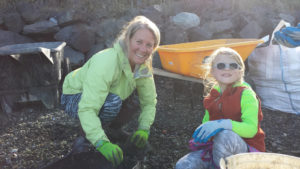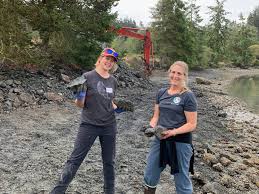In 2017, 600 linear feet of shoreline was improved along Shaw Island’s Blind Bay, a priority forage fish spawning region in the county. The surf smelt that spawns year round on the beaches of Blind Bay requires small gravel and sand to successfully incubate their tiny eggs. Friends of the San Juans led efforts to remove the large angular rocks that, over the decades, had fallen from armoring structures and covered large portions of the natural beach.
Work occurred at two locations along the bay in 2017, with different restoration methods. At one site, which hosted large volumes of rock slated for removal, contractors mobilized large equipment and mechanically removed about 120 cubic yards of large rock. A combination of sand and small gravel nourishment material, also known as ‘fish mix,’ was then brought in to restore suitable spawning substrate to the impacted beach.
 At a second smaller site, with a much thinner layer of angular rock, Friends worked with a Washington Conservation Corps crew, Shaw students, and volunteers to enhance the spawning site. Over six cubic yards of rock were removed from the beach surface, unburying the naturally smaller grained beach below. The cleared rock was placed into large bags that were removed using an excavator.
At a second smaller site, with a much thinner layer of angular rock, Friends worked with a Washington Conservation Corps crew, Shaw students, and volunteers to enhance the spawning site. Over six cubic yards of rock were removed from the beach surface, unburying the naturally smaller grained beach below. The cleared rock was placed into large bags that were removed using an excavator.
Friends also worked with local students to monitor the site and document potential changes in the distribution, density or success of incubating surf smelt eggs.
 In 2019, after seeing the positive results of the first enhancement actions, Friends was able to partner with more landowners to remove large rock and concrete debris on Blind Bay. These efforts improved spawning substrate in this priority year-round forage fish spawning area.
In 2019, after seeing the positive results of the first enhancement actions, Friends was able to partner with more landowners to remove large rock and concrete debris on Blind Bay. These efforts improved spawning substrate in this priority year-round forage fish spawning area.
Project acknowledgements: Shaner Excavation, Shaw Island Excavation, Coastal Geologic Services, and Caldera Archeology.
Funding was provided by: Friends members, the Washington State Salmon Recovery Funding Board, and the U.S. Fish and Wildlife Service.
